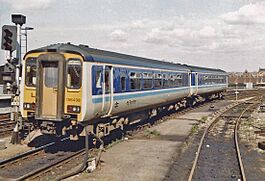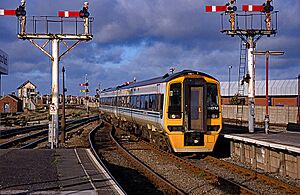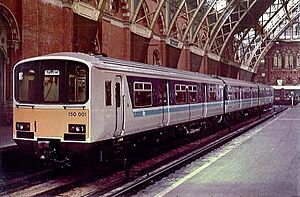Regional Railways facts for kids
 |
|
|---|---|

156438 at Bristol Temple Meads, May 1989.
|
|
| Main region(s): | East Anglia, North West England, North East England, Wales, South West England |
| Other region(s): | East Midlands, West Midlands (region), Scotland, Merseyside |
| Parent company: | British Rail |
Regional Railways was a part of British Rail, a big train company in the UK. It was created in 1982 and ran trains until 1997. It was one of three main groups of trains.
At first, it was called Provincial. Regional Railways needed the most financial help from the government compared to the other train groups. When it started, it cost four times more to run than it earned from tickets.
This train group was split into eight smaller train companies when British Rail was privatised (sold to private companies). Regional Railways stopped existing on March 31, 1997.
Contents
How Regional Railways Started
In 1982, British Rail decided to split its passenger services into three main parts. This was called sectorisation.
- InterCity ran the fastest express trains between major cities.
- London & South East (later called Network SouthEast) handled trains for people travelling to and from London.
- Provincial (which became Regional Railways in 1989) was in charge of all other passenger trains. This included local services and express trains to places not covered by InterCity.
In some big cities, local train services were managed by special transport groups called Passenger Transport Executives.
Train Services and Routes
Regional Railways took over many different train routes. These included both fast express services and slower local services. The express trains usually went to towns and cities that weren't the biggest main destinations. For example, they ran from Birmingham or Liverpool to Norwich, or from Liverpool to Scarborough.
At first, these express services often used older locomotives (train engines) and coaches (passenger carriages) that had been used by InterCity. Later, newer trains called Sprinter units were used, especially the British Rail Class 158 for express routes. In Scotland, there were also local services and express trains, like the special push-pull service between Edinburgh and Glasgow.
Local services ran on both main railway lines and smaller branch lines. These trains often used older diesel multiple units (DMUs) from the 1950s. Longer journeys sometimes used older coaches pulled by locomotives like the British Rail Class 31, British Rail Class 40, and British Rail Class 45.
Alphaline Express Services

The Alphaline brand was introduced in December 1994. This was for express services run by Regional Railways in the Midlands, Wales, and the South West of England. These trains connected different towns and cities. They worked alongside the more famous InterCity network, helping people travel across the country.
Developing New Trains
In the early 1980s, many older diesel trains and coaches were found to contain asbestos, a dangerous material. Removing it would be very expensive and wouldn't make the trains earn more money. Also, the old trains and engines were often breaking down. Because of this, British Rail decided it needed to buy a new generation of diesel trains.
A test train, the Class 210 , had been tried out since 1981. However, it was too expensive to build many of them. So, British Rail looked for other new train designs.
Pacer Trains
The first new design was the Pacer train. These trains used parts from buses, like the Leyland National bus. They were given numbers in the 14X range.
Soon after they started running, many Pacers had technical problems, especially with their gearboxes. In Cornwall, their long wheelbases (the distance between their wheels) caused loud squealing noises and wore down their wheels quickly on tight curves. Because of this, the old diesel trains had to be brought back to replace them there. After many changes and fixes, the Pacer trains eventually became more reliable.
Sprinter Trains
British Rail needed trains that were better than the Pacers but not as expensive as the Class 210s. In 1984 and 1985, two experimental diesel train designs were tested. British Rail Engineering Limited built the Class 150 , and Metro-Cammell built the Class 151 . Both of these used a special type of automatic gearbox called hydraulic transmission and were less like buses than the Pacers.
After testing, the Class 150 was chosen to be built in large numbers. These trains started running in 1987. The new trains were much more reliable. They only needed to visit the train depot for maintenance every two weeks, instead of two or three times a week.
In the late 1980s and early 1990s, new express services were also developed. These services worked with the main InterCity routes. The Class 155 and Class 156 Sprinter trains were designed to replace older trains pulled by locomotives on these routes. Their interiors were made comfortable for longer journeys. Important routes in Scotland and across the Pennine mountains were improved with new Class 158 Express Sprinter trains. Also, the 'Alphaline' network of services was introduced in other parts of the country.
By the end of the 1980s, more people were travelling by train, and the costs of running the trains had been reduced.
Electric Trains
The Class 323 electric multiple units (EMUs) were built between 1992 and 1995 by Hunslet Transportation Projects and Holec Ridderkerk. Test versions were built and tried out in 1990 and 1991. Forty-three of these trains, each with three carriages, were built for local services in and around Birmingham and Manchester. This included the Cross-City Line in Birmingham and services to the new Manchester Airport station.
Train Fleet (Rolling Stock)
Regional Railways used a variety of trains, including older locomotive-hauled coaches and newer diesel and electric multiple units.
| Class | Image | Quantity | Type of Train | Notes |
|---|---|---|---|---|
| Trains Pulled by Locomotives | ||||
| British Rail Class 31 |  |
Diesel Locomotive | ||
| British Rail Class 37 |  |
|||
| British Rail Class 47 |  |
|||
| British Railways Mark 1 |  |
Coach | ||
| British Railways Mark 2 |  |
|||
| British Railways Mark 3 |  |
|||
| Diesel Multiple Units (DMUs) | ||||
| British Rail Class 101 |  |
35 | 2, 3 or 4 carriages | |
| British Rail Class 117 |  |
3 | 3 carriages | |
| British Rail Class 121 |  |
26 | 1 carriage | |
| British Rail Class 122 | 29 | |||
| British Rail Class 142 Pacer (train) |
 |
96 | 2 carriages | 60 units scrapped, 31 units preserved, 4 units changed for non-railway use |
| British Rail Class 143 Pacer (train) |
 |
25 | 11 units preserved, 12 units scrapped, 2 units changed for non-railway use. | |
| British Rail Class 150 British Rail Sprinter |
 |
137 | 2 or 3 carriages | |
| British Rail Class 151 British Rail Sprinter |
 |
2 | 3 carriages | Both scrapped |
| British Rail Class 153 British Rail Sprinter |
 |
70 | 1 carriage | |
| British Rail Class 154 British Rail Sprinter |
 |
1 | 2 carriages | A converted class 150, converted back to a class 150. |
| British Rail Class 155 British Rail Sprinter |
 |
47 | ||
| British Rail Class 156 British Rail Sprinter |
 |
114 | ||
| British Rail Class 158 British Rail Sprinter |
 |
182 | 2 or 3 carriages | |
| Electric Multiple Units (EMUs) | ||||
| British Rail Class 304 |  |
45 | 4 carriages | All scrapped |
| British Rail Class 305 |  |
3 or 4 carriages | ||
| British Rail Class 323 |  |
43 | 3 carriages | |
Train Colours (Livery)
At first, many Regional Railways trains had the standard British Rail blue colour scheme.
From 1986, the Provincial sector (which became Regional Railways) started using a new design. This was aircraft blue on the bottom half and white on the top, with a light blue stripe in the middle. All new trains, and some older ones like certain Class 304 EMUs, were painted in these colours. Some trains and coaches also had ScotRail or Regional Railways written on them. In the North West, the light blue stripe was changed to a mid-green one on Class 156 trains that were updated between 1995 and 1998.
The British Rail Class 158 trains, which started running in 1989, had an Express colour scheme. This had dark grey around the windows over a light grey body, with light and dark blue stripes in the middle. Later, the word Alphaline replaced Express. This colour scheme was also put on some Class 156 trains around the time of privatisation.
The Class 323 electric trains, introduced in 1994, had special colours depending on where they ran. Trains based in the West Midlands had West Midlands Passenger Transport Executive (Centro) colours. Trains based in Manchester had Greater Manchester Passenger Transport Executive (GMPTE) colours.
After British Rail was privatised, many trains kept the basic Regional Railways colours. However, they added new branding from the different private companies, like Central Trains.
The very last British train to have the Regional Railways colours was a Class 153 train. It was repainted in July 2008 with East Midlands Trains colours.
Splitting Up for Privatisation
Between 1994 and 1997, British Rail was privatised, meaning it was sold off to private companies. As part of this process, Regional Railways was divided into several different "shadow" train companies. These later became independent train operating companies:
| New Train Company | Routes They Ran |
|---|---|
| Anglia Railways | Train routes in East Anglia (this also included some InterCity services in that area). |
| Valley Lines | Local 'Valley Lines' services around Cardiff, which used to be part of the South Wales and West divisions. |
| Central Trains | The central part of Regional Railways, covering the English Midlands and Mid Wales. Some services were moved to Anglia Railways or the Oxford to Worcester route. |
| Arriva Trains Merseyside | The network of electric train routes around Liverpool. |
| First North Western | Train routes in the North West of England and in North Wales. |
| Arriva Trains Northern | Train routes in the North East of England. |
| ScotRail (National Express) | Most of the train services within Scotland. |
| Wales & West | A large network of services based in South Wales and the South West of England. |




